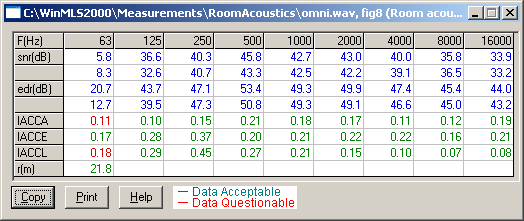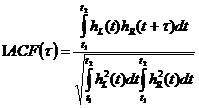Interaural crosscorrelation will be calculated if the microphone type is set
to  in
Calculate->Calculation Options... as shown below
in
Calculate->Calculation Options... as shown below

An example of computation is shown below.

Calculation of the binaural interaural crosscorrelation parameters are normally done from a binaural pair of impulse responses, measured either with a dummy head or microphones in or close to the ears on a real person. It requires microphone option Binaural pair. It is not important that the responses are mutually synchronized (for more information see the section below). The primary response is taken as the left side and the secondary as the right side.
The interaural crosscorrelation function is defined as
 (11)
(11)
where hL(t) and hR(t) are the left and right ear impulse responses respectively. The interaural crosscorrelation coefficient is taken as:
 (12)
(12)
WinMLS calculates three versions of the IACC; total with time limits t1 = 0 and t 2= ¥, early with time limits t1 = 0 and t2= 80 ms, and late with time limits t1 = 80 ms and t2 = ¥. The time limits t2 for IACC early (early time) and t1 for IACC late (late time) can be changed if the parameter is calculated from Calculate->User Defined.
The upper integration limit t2=¥ for IACC total and late is taken as the truncation point determined in the decay curve formation for the two impulse responses separately, or the end of the impulse responses, according to the integration option specified.
The calculation of IACC is substantially more time consuming than the other parameters, even if it is implemented using a fast frequency domain algorithm. This is especially true for the late and the total versions. If you are calculating parameters using Calculate->User Defined and if not explicitly needed, these parameters should therefore be excluded from the calculations.